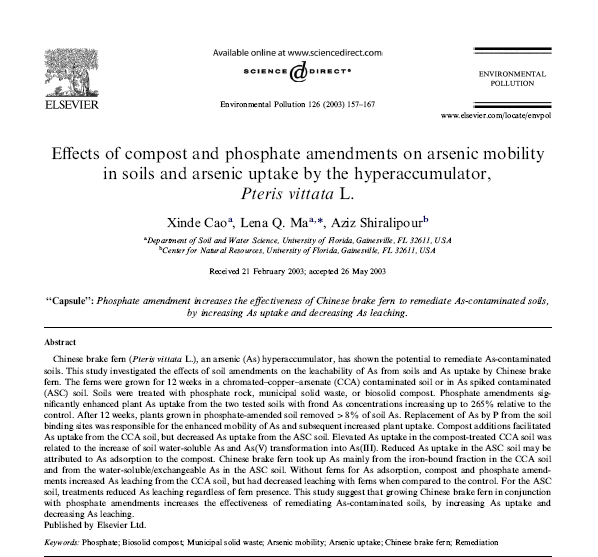Effects of compost and phosphate amendments on arsenic mobility in soils and arsenic uptake by the hyperaccumulator, Pteris vittata L.
2017-11-27
Xinde Cao, Lena Q. Ma, Aziz Shiralipour
Abstract
Chinese brake fern (Pteris vittata L.), an arsenic (As) hyperaccumulator, has shown the potential to remediate As-contaminated soils. This study investigated the effects of soil amendments on the leachability of As from soils and As uptake by Chinese brake fern. The ferns were grown for 12 weeks in a chromated–copper–arsenate (CCA) contaminated soil or in As spiked contaminated (ASC) soil. Soils were treated with phosphate rock, municipal solid waste, or biosolid compost. Phosphate amendments significantly enhanced plant As uptake from the two tested soils with frond As concentrations increasing up to 265% relative to the control. After 12 weeks, plants grown in phosphate-amended soil removed >8% of soil As. Replacement of As by P from the soil binding sites was responsible for the enhanced mobility of As and subsequent increased plant uptake. Compost additions facilitated As uptake from the CCA soil, but decreased As uptake from the ASC soil. Elevated As uptake in the compost-treated CCA soil was related to the increase of soil water-soluble As and As(V) transformation into As(III). Reduced As uptake in the ASC soil may be attributed to As adsorption to the compost. Chinese brake fern took up As mainly from the iron-bound fraction in the CCA soil and from the water-soluble/exchangeable As in the ASC soil. Without ferns for As adsorption, compost and phosphate amendments increased As leaching from the CCA soil, but had decreased leaching with ferns when compared to the control. For the ASC soil, treatments reduced As leaching regardless of fern presence. This study suggest that growing Chinese brake fern in conjunction with phosphate amendments increases the effectiveness of remediating As-contaminated soils, by increasing As uptake and decreasing As leaching.
Published by Elsevier Ltd.
Keywords: Phosphate; Biosolid compost; Municipal solid waste; Arsenic mobility; Arsenic uptake; Chinese brake fern; Remediation
